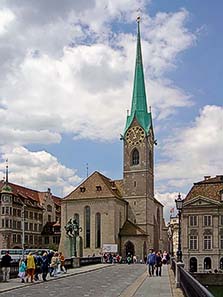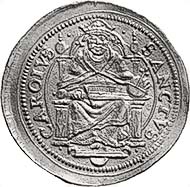The Saints of Zurich
by courtesy of Heiner Stotz, LHS Zurich
Have you ever been to Zurich? Perhaps during the last week of October, when the distinguished auction houses of Zurich hold their autumn sales? If you were, I am sure that you would have crossed the River Limmat by the Münsterbrücke while you were hurrying here and there in order to see all the interesting coins for sale. So please, close your eyes, and imagine the skyline of Zurich you saw from the bridge.
Fig. 1: View of Fraumünster seen from the Münsterbrücke. Photo: Sidonius / Wikipedia
To the left are the spires of the Fraumünster, to the right those of the Grossmünster.
Fig. 2: View of Großmünster and the Wasserkirche. Photo: Roland, zh / Wikipedia
With two so eminent churches so close to each other, it is somehow natural that there was constant friction between them over which one was the more important. During each dispute the canonesses of the Fraumünster produced a document issued by Ludwig the German and still to be found in the archives of the convent. There everybody could read that the great German emperor had given important gifts to the nunnery because his daughter Hildegard was the abbess of the Fraumünster convent. The Grossmünster – which was at least as old as the Fraumünster, but couldn’t prove this – had no document of comparable age, but called upon a legend saying that the most important saints of Zurich – Felix and Regula – were buried where the church was built.
The legend says that Felix was a member of the famous Thebean legion from Egypt, the location of whose martyrdom has been claimed by an incredible number of different places in Switzerland, France and Germany. Mauritius, commander of the Thebean legion and first owner of the sacred lance that later formed a part of the imperial regalia, is said to have foreseen the persecution of Christians by Maximinianus Herculius (286-305). He advised Felix to seek refuge with his sister Regula. It is said that the myrmidons of Maximianus followed them and hunted them down at the castle of Turicum – today’s Zurich. The siblings were tortured, but Felix and Regula refused to give up their faith. At that point they were brought outside of the castle to be executed.
Fig. 3: View of the Wasserkirche, seen from the Münsterbrücke. Detail of Fig. 2
Standing on the Münsterbrücke you can see where it happened: you only have to turn around, and at your right side you’ll see a little Gothic building called the Wasserkirche. If you happen to have a close friend at the Zurich office for preservation of monuments, you might even be able to enter the underground crypt and view the stone where Felix and Regula are said to have finished their lives. They were decapitated and the legend says that they took their heads and walked – just as St. Dionysius of Paris or Klaus Störtebecker from Hamburg – to the place where the Grossmünster now is. There they were buried.
But a Saint would not be a Saint if he just stayed in his grave like an average corpse. And Felix and Regula were found by nobody else but Charlemagne! He saw a stag outside of Cologne and then followed him until they came to Zurich (a long chase then and now) and arrived at the place where Felix and Regula were buried. The stag stopped there, fell to his knees and the Emperor immediately realized that he had to build a church and a monastery in Felix and Regula’s honor.
Fig. 4: Copy of the statue of Charlemagne on the southern tower of the Grossmünster
(the original can be seen in the crypt). Native citizens of Zurich will tell you that this stone statue will throw bread from the tower of the Grossünster as soon as he hears the 6th stroke of the church’s bell. This is absolutely true. Or would you believe a stone statue being able to hear? Foto: roland, zh / Wikipedia
Let’a avoid a discussion about the truth of this story. We just have to remember that in medieval Zurich this legend was considered to be true. And Charlemagne outranked Ludwig the German. Therefore, apart from Felix and Regula, “Charles the Great” was also honored at the Grossmünster in order to demonstrate to those pesky nuns at the Fraumünster that the Grossmünster was much older and much more important than their convent. There still exists a statue of Charlemagne showing him with an imperial crown and the sword of judstice. This was a symbol of the imperial fullness of power that called the Grossmünster into being. And now the clergymen there could boast of their noble origin.
Fig. 5: ZURICH. Dicken without date (1500-1503). Tobler (1974), S. 77 (this specimen). HMZ 1124. Sale 88 Leu Numismatics (2003), lot 1787. Estimate: 20.000 CHF. Hammer price: 31.000 CHF.
On the first dicken of Zurich – a coin that was minted about 1500 – Charles the Great is shown exactly the way he could be seen at the Grossmünster. This wasn’t the first time that the citizens of Zurich used this image on a coin: they already had placed him on their plapparts of 1417 and 1424. They had chosen this motif deliberately because they didn’t want to place Felix and Regula on their coins. Officially, the abbess of Fraumünster still was the owner of minting rights for the city and her predecessors had minted coins with the images of Felix and Regula.
Fig. 6: ZURICH. Fraumünster abbey. Abbess Judenta of Hagenbuch, 1229-1254. Penny. Cahn-Wüthrich 203var. Sale 88 Leu Numismatics (2003), lot 1730. Estimate: 600 CHF. Hammer price: 1.000 CHF.
This is because when some relics were transfered in 873/5, the Fraumünster also owned various parts of the bodies of Felix and Regula. And they also had their own legend about a stag, this time one guiding the daughters of Ludwig the German to the place where the Fraumünster was founded.
By the way, the type of Zurich’s coins changed soon after the minting of the first dicken. The citizens of Zurich gained self-confidence and the abbess of Fraumünster lost power. Now Felix and Regula were annexed by the council of Zurich and they can be seen on the coins of Zurich.
Fig. 7: ZURICH. Guldiner 1512. Hürl. 422. HMZ 1121. Sale 88 Leu Numismatics (2003), lot 1806. Estimate: 12.500. Hammer Price 12.000 CHF.
But on a crown of 1512 we find not only Felix and Regula, but a third headless personnage, St. Exuperantius. His cult only dates back to the 13th century, while the earliest references to a cult in honor of Regula and Felix can be found in the 9th century. Exuperantius was a new discovered (in medieval times that was another word for invented) saint specially related to the citizens of Zurich.
We have nearly reached the end of our legends and stories. On January 29, 1523 the council of Zurich decided to accept the Reformation. One year later, on November 30, 1524 the Fraumünster was dissolved. The last abbess was given a pension, married and was never mentioned again in the archives of the city. Together with the Fraumünster all Catholic institutions were dissolved.
Just to mention it, the Saints of Zurich didn’t vanish completely after the Reformation.
Fig. 8: ZURICH. 2 Ducats without date (1588-1600, mintmaster Hans Ulrich III. Stampfer). HMZ 1136. From the upcoming auction 88 of Leu Numismatics (2003), lot 1851.
We see them again on an undated double ducat that was minted betwen 1588 and 1600. On the obverse there are Felix and Regula, on the reverse there is Charles the Great. The smart Zurich businessmen seem to have insisted on the old types in order to find better acceptance for their ducats when using them in Catholic areas.
You have never been to Zurich? Do I arouse your curiosity? Come and visit the city this year during the numismatic week.



















